By Sharon DeBartolo Carmack
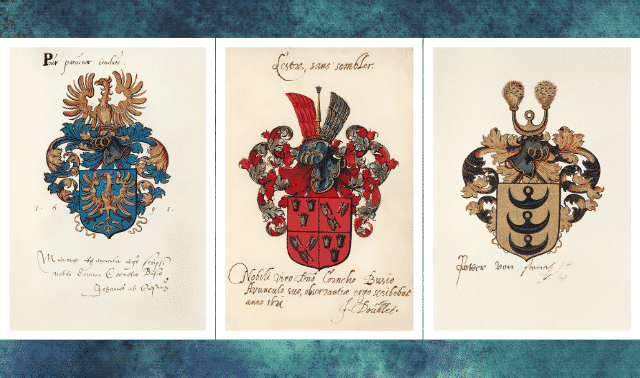
In our supposedly classless, egalitarian society, nobility wannabes are fueling a craze for that symbolic representation of a person’s heritage known as a coat of arms, often mistakenly called a “family crest.” Rare is the family historian who doesn’t hope to be descended from an ancestor who was armigerous (that is, according to Webster’s, “bearing heraldic arms”). Most however, are disappointed to find their ancestors weren’t actually entitled with the right to bear arms. Learn what’s and what’s history when it comes to heraldry.
Hearldry Facts
For starters, a key fact to keep in mind is that coats of arms are not and never have been granted to families. They’re granted to individuals and belong to individuals. Arms can, however, be inherited. According to an informational brochure, “Heraldry for United States Citizens,” published by the Board for Certification of Genealogists (BCG):
- Anyone whose uninterrupted male-line immigrant ancestor was entitled to use a coat of arms has the right to use this same coat of arms.
- If the uninterrupted male-line immigrant ancestor has no such right, then neither does the descendant.
- Anyone who claims the right to arms under European laws must prove the uninterrupted male-line descent.
- As an exception, United States citizens can obtain a grant or confirmation of their arms—from the College of Arms in England or other appropriate national heraldic authority in other countries—by payment of required fees.
The brochure also warns, “Commercial firms that purport to research and identify coats of arms for surnames or family names—and sell descriptions thereof under the guise of a ‘family crest’—are engaged in fraudulent and deceptive marketing. The consumer’s best defense is a proper knowledge of the laws of heraldry.”
While the laws of heraldry differ with each country, in some parts of the world it’s actually illegal to display a coat of arms or to use it on stationery or a blazer breast pocket unless you’re the rightful owner. Having the same last name does not entitle you to use the arms. Here in the US, you won’t be thrown in the slammer if you’ve already bought and proudly displayed in your living room what you thought was your family crest.
And who knows? You could really be descended from an ancestor who rightfully inherited a coat of arms. To find out, let’s journey back in time to learn how coats of arms originated, what they mean and how to discover if any of your ancestors had a legitimate claim to them.
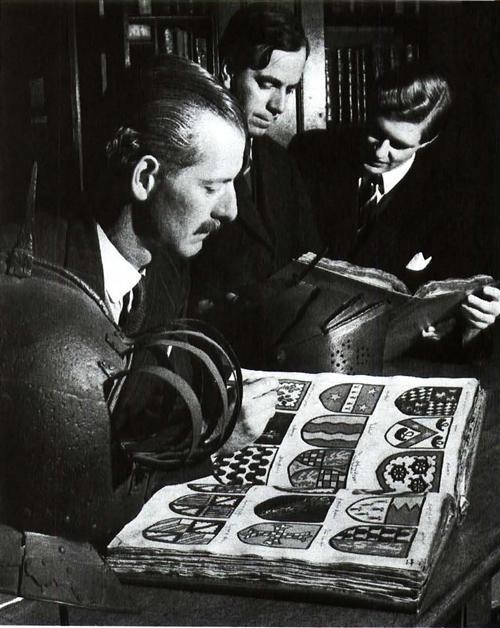
The History of Coats of Arms
Coats of arms developed in the 12th century as a means to identify armored knights during tournaments and on the battlefield. Any fighting man owned a sword and shield, carried a banner and wore a helmet, all of which his son would one day inherit. Behind a closed helmet, it was impossible to tell one man from another except by the decoration of his shield and banner and the ornaments on the helmet. The term “armory” relates to the emblems, “armoury” to weapons. Warriors also wore a decorated “surcoat,” or fabric overlay, over their armor — hence the term “coat of arms.”
Over time, these emblems became a means of personal identification, allowing an owner to mark items of value, such as silver, and to engrave bookplates and stationery. With their growing use and popularity, disputes arose over who could legitimately use a particular design. In 1484, Richard III established the College of Arms and assigned heralds to visit households across England to record each owner’s design. These “visitations” were made between 1530 and 1686.
Early on, arms were the signs of nobility and rank, but eventually practically any man who owned land also had the right to bear arms. Thus arms became a symbol of the gentry, and it became fashionable and prestigious to descend from a line with armigerous ancestors. Each country has its own laws as to who could inherit the arms. Commonly, the symbol was passed down from eldest son to eldest son in an unbroken male line. Other sons, and even daughters, might use variations of the main emblem, adding specific symbols — or cadency marks — to indicate birth order, illegitimacy and adoption.
The Elements of a Heraldic Achievement
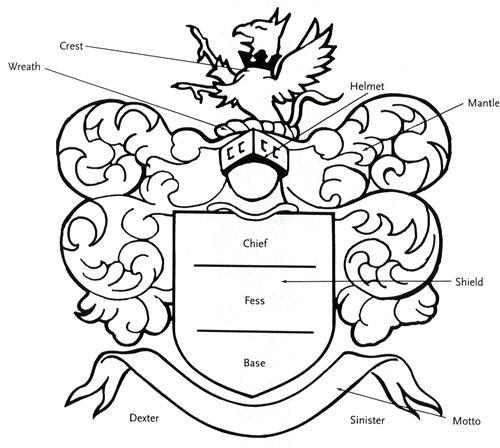

Although we commonly refer to it as a “coat of arms,” the proper term is a “heraldic or armorial achievement.” A complete heraldic achievement is made up of a crest, wreath, mantle, helmet, shield and, although not essential, a motto. There may also be supporters to hold up the arms and a compartment (or ground) for the supporters to stand on.
Crest
The crest is a figure or symbol attached to the top of the helmet. Animals such as lions, tigers and bears are commonly used as crests, but you’ll also find boars, foxes, horses, birds, insects, reptiles and mythical animals such as unicorns and dragons. These may stand alone or be combined with other symbols, such as flowers, trees, wreaths or swords.
Helmet
The helmet supports the crest. Positioning of the helmet represents rank: For example, a helmet facing forward with the visor opened means a knight, while a helmet facing side-ways with the visor closed is for a gentleman.
Wreath
The wreath, originally a piece of twisted silk showing two colors, is at the base of the crest and was used to attach the mantle to the helmet. Typically, the wreath shows six twists of alternating colors of the shield.
Mantle
The mantle (or lambrequin), originally a piece of fabric attached to the knight’s helmet to protect him from the sun’s heat, fills out the design. It represents the fabric being slashed in battle.
Motto
The motto is a ribbon below or over the achievement, which carries a statement of fact, a hope or battle cry.
Shield
The shield is the most important part of the coat of arms. It is made up of a field (the surface or background) and the charges (the symbols on the field). If the achievement belongs to a lady, the field will be diamond-shaped (a lozenge) rather than a shield. The field contains many different ordinaries and sub-ordinaries — geometric bands or shapes that divide the field, such as crosses, chevrons and stripes. The shield can become quite complex, with more terms than you’d care to know and remember. In describing a coat of arms (known as blazoning), the field is always stated first and the components are described as being dexter (right side of the wearer), sinister (left side of the wearer), chief (top), fess (middle) and base (bottom).
Tinctures
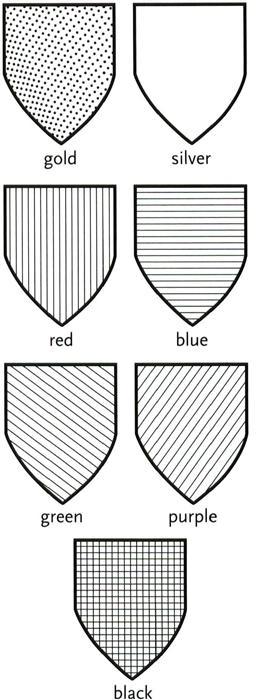
Tinctures—the colors, precious metals and furs on a coat of arms—are also represented by words and patterns. The two metals are gold (or) and silver (argent); the colors are red (gules), blue (azure), green (vert), purple (purpure) and black (sable); the furs are ermine and vair. In black-and-white illustrations specific conventions are used to indicate the colors, metals and furs. The written description (blazon) might read, “Quarterly gules and or, in the first quarter a five-point mullet argent,” which means the shield is divided into red and gold quarters, and in the first quarter, or the upper left as you look at the shield, is a silver, five-pointed star.
Hatchment
Another aspect of heraldry is the funeral achievement or hatchment. According to Theodore Chase and Laurel K. Gabel in “Headstones, Hatchments and Heraldry,” in Gravestone Chronicles II: More Eighteenth-Century New England Carvers, a hatchment is the “painted coat of arms associated exclusively with death, funerals, and mourning…. They are often set in decorated frames that depict mortality symbols such as hourglasses, skulls or bones” against a black background. These funeral hatchments “indicated to the viewer the gender, marital status and often the family position of the deceased” and also may be found carved on colonial New England and Virginia tombstones. According to Chase and Gabel, “In the United States, having an heraldic tombstone with a death date prior to 1750 is in fact sometimes considered proof of a legitimate right to bear arms.” Chase and Gabel are trying to find and record all the pre-1850 armorial tombstones in the United States. For information about the project, visit the Association for Gravestone Studies website.
Heraldry and Genealogy
Lacking a pre-1750 heraldic tombstone for your ancestor, how do you determine if one of your ancestors had a legitimate right to a heraldic achievement? Begin by checking the works of Sir John Bernard Burke and the Ten Rolls of Arms published in several volumes of the New England Historical and Genealogical Register. Large genealogical sections in libraries may have these. Unfortunately, beyond these and other published sources, your search can get quite complicated and time consuming. It’s not just a matter of looking up your surname; the proper descent must be traced and documented, which is why the bogus claims of “family crest” companies are so laughable.
As you research your family history, you may encounter a published genealogy on your ancestry that reproduces a coat of arms or “family crest,” but be extremely cautious of these and research for yourself the accuracy of its use. When I began researching my colonial Fitzhugh ancestry, I found two Fitzhugh coats of arms illustrated in volume two of Genealogies of Virginia Families from the Virginia Magazine of History and Biography (Genealogical Publishing Co.). One was quite familiar to me; a colorful reproduction had hung in my great-aunt’s living room for as long as I could remember. The genealogy described the shield as “Azure three chevrons interlaced in base or, a Chief or” — three gold chevrons (upside-down Vs) interlaced in the bottom half of the shield, which is blue and has a gold band across the top. The other one had a more complex description: “Quarterly, 1 and 4 ermine, on a chief gules, three martlets. 2 and 3 argent three chevrons sable each charged with a bezant.”
But William Fitzhugh, the immigrant from England who used the first achievement mentioned above, may not have been entitled to do so. According to the genealogy, William wrote to his brother Henry in London to send him an illustration of the arms. When William received it, he wrote back to his brother that it was incorrect, but Henry insisted it was the right one. The author of the family history, however, states that when he checked the visitations, he could not find an armigerous Fitzhugh who had a son named William: “Though the Virginia Fitzhughs bear the same arms as the old Barons Fitzhugh, of Ravensworth, no descent from the ennobled family has ever been traced.”
William the immigrant was not alone in wanting to display and use arms. It seems this coats of arms craze isn’t just a modern fad. Colonial ancestors, many of whom were not eldest sons and stood no chance of inheriting land or a title in Europe, adopted heraldic achievements as a status symbol once they had settled and made a name for themselves in America, whether they were entitled to arms or not. Between about 1750 and 1775, many wealthy colonial families hired painters specializing in heraldic arts to create a coat of arms for them. Some of these may have been legitimately registered with the College of Arms in England; others, not.
Heraldry References for Genealogists
- Burke’s Genealogical and Heraldic History of the Landed Gentry: Including American Families with British Ancestry, 3 vols., by Sir John Bernard Burke (Burke’s Peerage). (Burke compiled numerous volumes of heraldic history besides these.)
- Founders of Early American Families: Emigrants from Europe, 1607-1657 by Meredith B. Colket, Jr. (General Court of the Order of Founders and Patriots of America)
- New England Historical and Genealogical Register. See volumes 82 (Apr. 1982); 86 (July 1932); 106 (July and October 1952); 107 (January, April, July and October 1953); 112 (July and October 1958); 122 (January, April and July 1968); 125 (July and October 1971); 133 (April 1979); 145 (October 1991); and 146 (July 1992).
Heraldry and Coat of Arms Resources
Websites
- American College of Heraldry
- College of Arms
- Genealogia e Heráldica Portuguesa (Portuguese Genealogy and Heraldry)
- Heraldicá Escudos Genealogía Apellidos Nobleza (Heraldry for Genealogy Nobility Surnames of Hispanic Origin)
- The Heraldry Society
- Heraldry in Italy
- Institute of Heraldic and Genealogical Studies
- Office of the Chief Herald, National Library of Ireland
- Royal Heraldry Society of Canada
- Societas Heraldica Scandinavica (Heraldry Society of Scandinavia)
Books
- The Art of Heraldry: Origins, Symbols, and Designs by Peter Gwynn-Jones (Barnes and Noble)
- “The Coats of Arms Craze” in Milton Rubincam’s Pitfalls in Genealogical Research (Ancestry)
- A Complete Guide to Heraldry by Arthur Charles Fox-Davies (Wordsworth Editions)
- Design Your Own Coat of Arms: An Introduction to Heraldry by Rosemary A. Chorzempra (Dover Publications)
- “Headstones, Hatchments, and Heraldry, 1650-1850” in Theodore Chase and Laurel K. Cabel’s Gravestone Chronicles II: More Eighteenth-Century New England Carvers and an Exploration of Gravestone Heraldica (New England Historic Genealogical Society)
- Heraldry: A Pictorial Archive for Artists and Designers edited by Arthur Charles Fox-Davies (Dover Publications)
- The Oxford Guide to Heraldry by Thomas Woodcock and John Martin Robinson (Oxford University Press)
- The Symbols of Heraldry Explained by Heraldic Artists Limited
A version of this article appeared in the August 2000 issue of Family Tree Magazine.
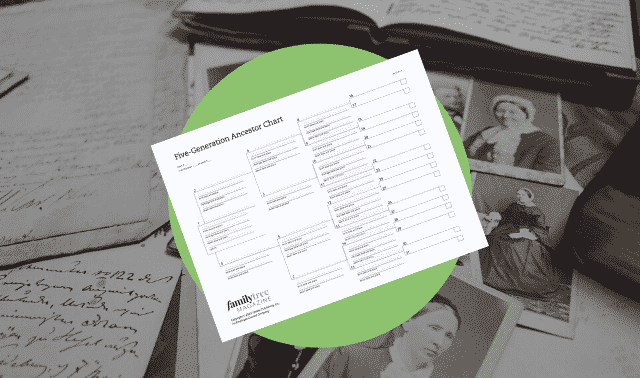
No comments:
Post a Comment